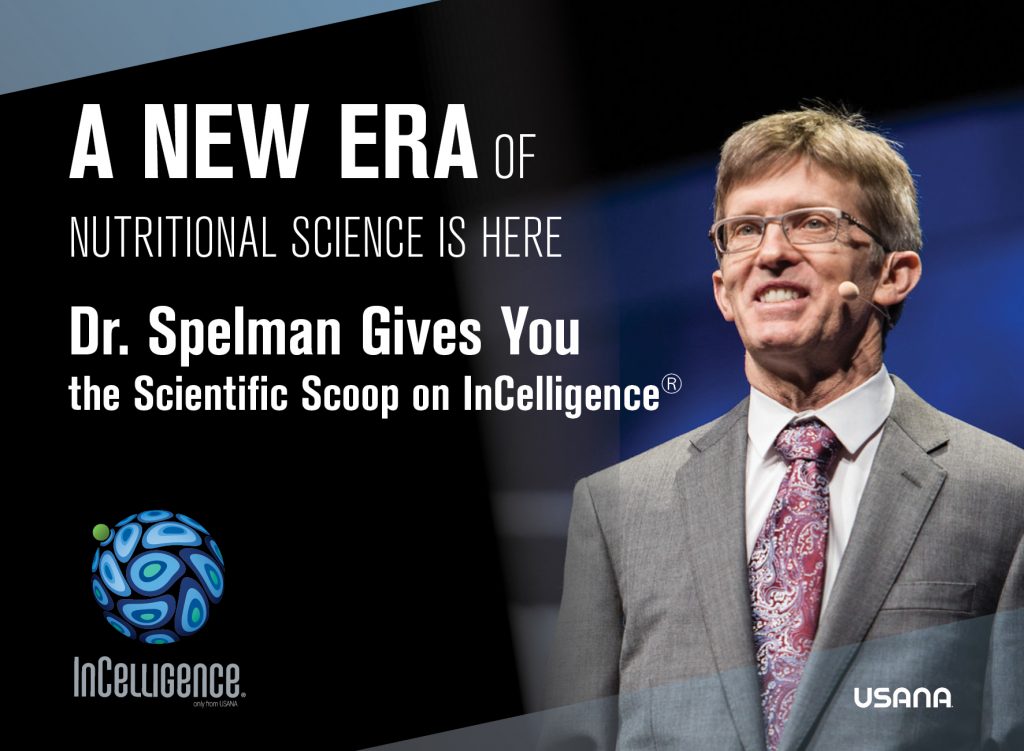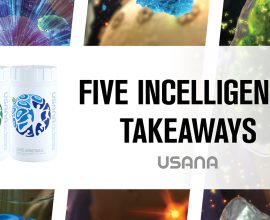
Dr. Spelman explains InCelligence
Those of us who said goodbye to test-tubes and lab coats in high school might be wondering why USANA decided to upgrade Essentials to CellSentials, and what on earth InCelligence is. There are a lot of big words and it can be hard to wrap your head around. But once you’ve got it, you’ll see why there’s so much fuss around it! Dr. Spelman, USANA’s very own Executive Vice President of Research and Development, has answers for some questions you may have about our cutting-edge nutritional science.
When did USANA start working on what would become InCelligence?
When Dr. Wentz first started feeding cells with various plant compounds, that’s when the foundations of InCelligence really started coming into play. From there to here is not necessarily a big shift. But it’s a continuing evolution in our understanding of how cellular processes work and the role that nutrients and plant-based biomolecules — various molecules from plants — play in supporting good cell-to-cell communication.
What sets InCelligence apart?
Three things set it apart. Number one is the actual targets we’re hitting, and number two is that multiple studies have come back showing these new ingredients actually activate these targets. The third piece is that we are able to carefully select which processes to turn on and off.
We’re hitting key targets that actually have a crucial role in foundations of good health. For example, NF-kB — a cell-signaling pathway—allows for modulating healthy inflammatory responses. Normal inflammation is a common occurrence in our busy lives today, popping up from things such as exercise. Supporting a healthy inflammatory response helps your body to maintain optimal health.
The second is that studies have actually observed that the new ingredients activate cell-signaling pathways: NF-kB, mTOR, NRF2, and PPAR. They can show they’ve impacted PPAR gamma signaling in some way, which also plays a role in healthy cellular communication and in supporting normal, healthy glucose and lipid metabolism.
Lastly, we really will be able to select key pathways to activate with the right messenger molecules; interestingly, many of these messengers are from healthy foods. This will only get more and more sophisticated as we continue our research.
Why are the antioxidants produced in our cells more powerful than those we take into our bodies?
The antioxidants we take in from the outside are limited by their ability to deal with one free radical at a time. This is effective and useful, but allows for quenching free radicals in a dose-dependent manner. Once an exogenous antioxidant — one from outside the body — has dealt with a free radical, either they have to be regenerated themselves, or we need another exogenous antioxidant.
Our endogenous antioxidants — the ones made in our cells — in many cases are actually enzymes, and they can process thousands of chemical reactions in as quick as one second. So it’s not a one-shot deal. Free radicals can keep coming at an antioxidant enzyme like superoxide dismutase and the enzyme just keeps disarming them.
How important is the cellular renewal process triggered within our cells?
There’s been quite a lot of excitement generated around mTOR and this target that has the ability to, first and foremost, process old mitochondria and take those parts and make new mitochondria.
That’s important because, first, mitochondria are the power centers of our cells. They produce ATP so we can fuel whatever needs to happen. Secondly, mitochondria generate, within themselves, a huge amount of free radicals. And every mitochondria will leak these free radicals into the cellular environment ever so slightly. As the mitochondria age, the membranes break down more and more, much as an old fence starts to become unstable and develop holes.
So free radicals will leave the mitochondria, and this can damage cellular components we call organelles — tiny cellular organs. As a result, once those mitochondria get old there can be significant damage to the cell. By being able to replace old mitochondria that are leaking free radicals at high rates, essentially what you’ve done is maintained health in the cell.
InCelligence proactively triggers natural responses. Why is that better than just waiting for them to occur naturally?
If we go back to Paleolithic times, when humans had more variety of plant foods in their diets , the high number of select plant molecules ingested triggered a large number of protective biochemical processes, many of which the medical sciences are still learning about. This was a good thing. It promoted signaling in our bodies that was very helpful to our health. With USANA InCelligence, which contains key plant molecules that activate the pathways we previously talked about, what we’re really doing is returning to a time when these beneficial processes were stimulated more frequently than lots of people get these days due to poor diets.
Bottom line, what does the Science of InCelligence mean to current and future users of USANA products?
The Science of InCelligence means we’re going to get better and better, and be at the forefront of science of nutrition. We will be able to tap into multiple targets to optimise cellular nutrition and function — which will have far-reaching effects, reaching into our bodies for the best possible health outcomes.
You can find the product of this cutting-edge nutritional science here if you want to try it for yourself or find more information!




